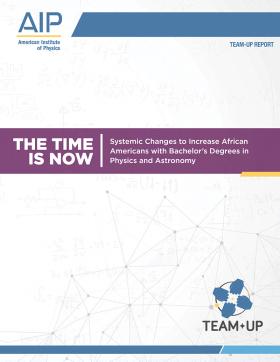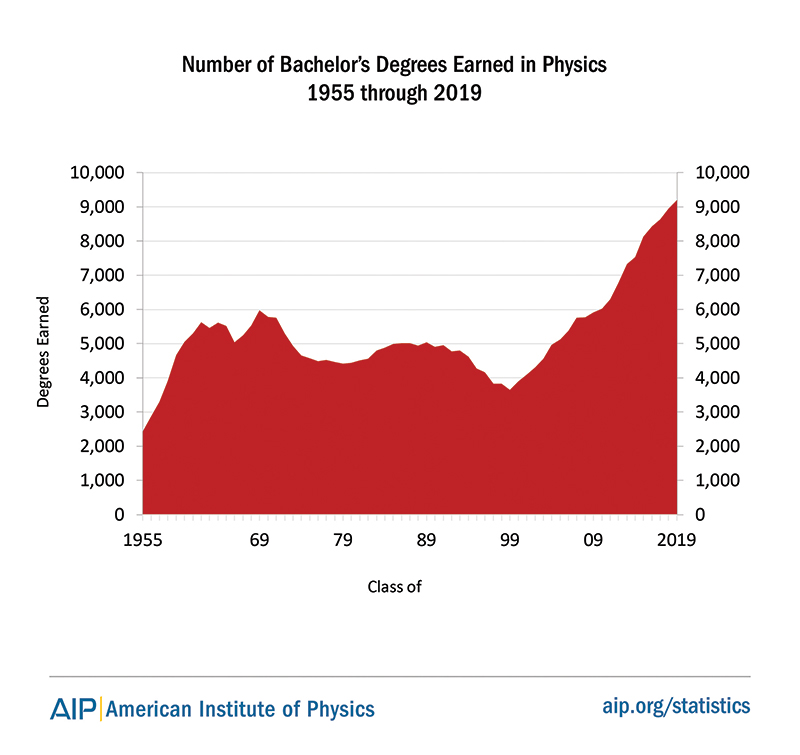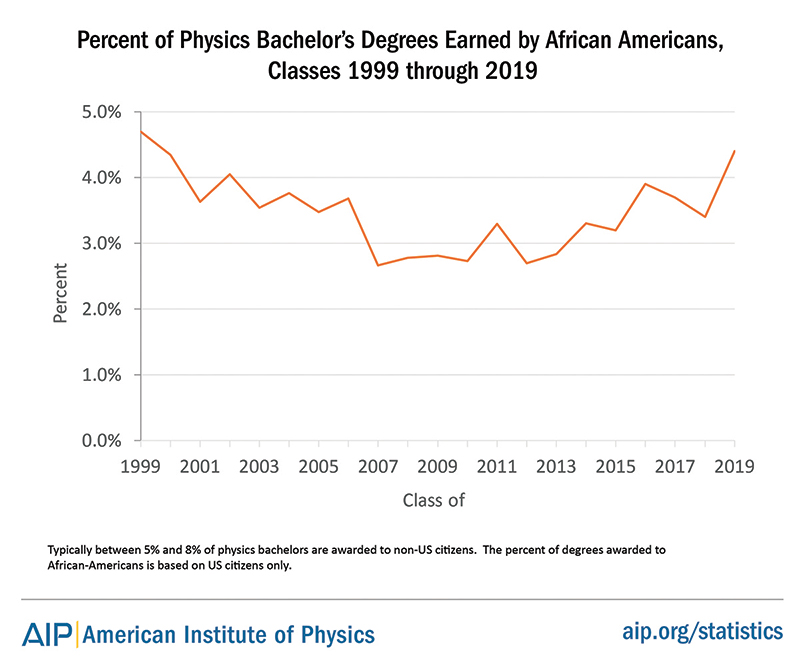A Problem with Physics
Fall
2020
Feature
A Problem with Physics
Kendra Redmond, Editor
 In the past 20 years, the number of physics and astronomy bachelor’s degrees awarded in the United States has more than doubled.
In the past 20 years, the number of physics and astronomy bachelor’s degrees awarded in the United States has more than doubled.
Over the same time period, the number of African American students earning bachelor’s degrees in all fields has grown much faster than can be accounted for by population growth. This holds true for the subset of those earning degrees in all physical science fields.1
Interest in physics is rising. The percentage of African American students earning bachelor’s degrees in the US is rising. Yet the percentage of physics and astronomy bachelor’s degrees earned by African American students has been persistently and inexcusably low—in the 2%–5% range.
Decades of efforts to increase diversity in physics have met with varying levels of success, but none have visibly shifted the national picture for African American students2 in physics and astronomy.
The Time is Now
In 2017 the American Institute of Physics3 convened TEAM-UP4, a task force of physicists, astronomers, and education researchers. The group was charged with studying the experience of African American undergraduates and identifying how the physics and astronomy culture impacts their persistence in the field.
Through student focus group sessions, site visits, student surveys, and departmental surveys, TEAM-UP identified a number of systemic changes urgently needed in physics and astronomy departments and institutions at large. Some of these are highlighted here, and the complete findings and corresponding recommendations are detailed in the TEAM-UP report, “The Time is Now: Systemic Changes to Increase African Americans with Bachelor’s Degrees in Physics and Astronomy.”
TEAM-UP Findings and Recommendations
Key factors that affect the success or failure of African American students in physics and astronomy include belonging, physics identity, academic support, personal support, and leadership and structures. Most of the TEAM-UP findings and recommendations are categorized according to these five factors. Below are selected examples; to read the full report, which includes 20 key findings and 30 recommendations, visit the AIP website at www.aip.org/teamup.
Belonging
A sense of being a welcomed and contributing part of the physics and astronomy community.
Key finding: Faculty interactions have a powerful effect on student retention in, or departure from, the major. Students’ sense of belonging increases with the number of faculty who get to know them as individuals and demonstrate support for their success.
Recommendation: Faculty who teach or advise undergraduates should become aware that counterspaces (e.g., family, churches, Black student organizations) are important for African American students and should assist students in finding the support they need inside and outside the department.


Physics Identity
Perceiving oneself and being perceived by others as a future physicist or astronomer.
Key finding: The connection of physics to activities that improve society or benefit one’s community is especially important to African American students.
Recommendation: Departments should communicate the ways in which a physics degree empowers graduates to improve society and benefit their communities, for example, by inviting alumni to speak to students about these issues.
Academic Support
Effective teaching that builds on strengths rather than focuses on presumed deficits.
Key finding: Faculty who teach well and demonstrate commitment to students by affirming their academic abilities, encouraging their success, and helping them find additional resources are critically important in fostering student success.
Recommendation: Departments should adopt policies and practices that encourage multiple faculty, including those who are not members of marginalized groups, to engage in formal and informal mentoring of students, and they should recognize and reward these efforts.
Personal Support
Easy and destigmatized access to support for nonacademic needs.
Key finding: Financial stress is particularly high for many African American students given the documented enormous racial wealth disparities in the US. Colleges and universities improve student retention and graduation by providing emergency support.
Recommendation: Departments should identify campus resources for emergency financial aid, conference travel, and other unmet needs and help students take advantage of them.
Leadership and Structures
Department leaders designing environments, policies, and structures that maximize success.
Key finding: Lone champions [within the department] can make a big difference for students, but their effort is unsustainable, making this an ineffective long-term strategy. In the most successful departments, a significant fraction of the faculty consistently values and supports underrepresented students.
Recommendation: Departmental administrators should become familiar with and encourage students to utilize campus resources, including student affairs offices, dual-degree programs, research funding programs, multicultural centers, tutoring centers, etc.
What will it take?
To catalyze real change and at least double the number of bachelor’s degrees in physics and astronomy awarded to African American students by 2030, TEAM-UP is calling on the physics and astronomy community to provide
- Supportive departments in which the faculty is deeply engaged in improving outcomes for African American students, and
- Significant financial support for African American students and historically Black colleges and universities that relieves some of the unjust burden of racial wealth disparities, ideally in the form of a $50 million endowment.
Help solve the problem
- Read the TEAM-UP report, “The Time is Now,” available at www.aip.org/teamup.
- Consider the climates you help foster, on campus and otherwise, and how you can implement any relevant recommendations.
- If you’re a faculty member, administrator, or member of a professional society, consider participating in an upcoming TEAM-UP implementation workshop. For details see www.aip.org/teamupworkshops.
- If you’re an alumnus, reach out to your home or local SPS chapter (https://www.spsnational.org/about/governance/zones) to offer support in line with these recommendations.
- Connect with SPS chapters and members by joining the SPS Alumni Engagement Program, www.spsnational.org/programs/alumni-engagement.
- Financially support physics undergraduates in need of emergency funding due to negative impacts of the COVID-19 pandemic through the SPS Emergency Scholarship Fund, https://foundation.aip.org/student-programs.html.
References:
1. The percentage of African American students earning physical science degrees has increased by 36%, compared with a 23% population growth rate.
2. For consistency with previous data collection efforts and the wording of its charge, TEAM-UP used “African American” to refer to Black students earning physics bachelor’s degrees in the United States.
3. AIP is the parent organization of Sigma Pi Sigma.
4. The Task Force to Elevate African American Representation in Undergraduate Physics and Astronomy.
TEAM-UP Voices
“For so long, efforts to increase the numbers of African American students in physics have focused on ‘fixing’ these students. An important message from the TEAM-UP study is that they don’t need fixing . . . Departments have to do the work to break down harmful structures and rebuild those that will truly support African American students and ultimately all.”- Arlene Modeste Knowles, AIP Diversity Task Force Project Manager, TEAM-UP
“The biggest barrier for me was finance. It was really hard to succeed and make the most of my undergraduate experience when I was constantly worrying about feeding myself and paying for rent.”
- Student comment during a TEAM-UP focus group session
“We physicists are so steeped in the community, and also in looking at specific science problems, that [when we tackle issues like diversity and inclusion] we’re not looking at the whole community, we’re not taking a holistic view. Because of [the sociologists on the team] we had a robust survey and we were able to hear student voices directly.”
- Tabbetha Dobbins, Interim VP for Research and Dean of the Graduate School, Division of University Research and Associate Professor, Department of Physics & Astronomy, Rowan University; TEAM-UP task force member
“Sometimes you feel like you can do it, and then it’s like, what if you can’t? . . . You go into a class and you’re the only [Black] person there. There’s already the pressure of ‘I have to be top notch. I have to do what I got to do.’ I feel like sometimes that can get in the way of personal success.”
-Student comment during a TEAM-UP focus group session
“At this point there is really no excuse. We have all seen the data over and over, heard the stories, and have clear recommendations to address each finding. The only thing left to do is to act upon them.”
- Brian Beckford, Physicist and Program Manager, Office of High Energy Physics, Office of Science, Department of Energy, TEAM-UP Task Force member
The views and opinions expressed here are personal and not intended to reflect the views of any organization or employer.
